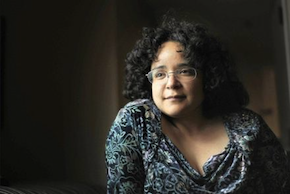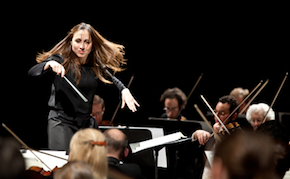
What is in the air right now that is impelling so many contemporary artists to explore the mysteries of holy women? Only a year after the world premiere of John Adams’ passion oratorio, The Gospel According to the Other Mary, which threads together stories of Marys from several religious traditions, and less than two months before the San Francisco Opera world premiere of Mark Adamo’s opera The Gospel of Mary Magdalene, the San Francisco Girls Chorus (SFGC) premieres Gabriela Lena Frank’s two-part oratorio about sacred sisters.
As yet unnamed, albeit sometimes referred to as Santos, the oratorio encompasses Mary Magdalene and other holy women, in a prelude titled “Holy Sisters,” and, in its second part, “Santos,” a crisis of faith that’s resolved by saintly intervention.
The complete oratorio’s world premiere, which takes place a little over a year after the premiere of “Holy Sisters,” includes texts by two different librettists. The Prelude, which sets the words of José Tolentino de Mendonça, serves as a bridge to very different text by Pulitzer Prize–winning playwright Nilo Cruz.
Uniting the two parts of the oratorio, first and foremost, are the miraculously luminous voices of the San Francisco Girls Chorus. They are partnered by the Berkeley Symphony Orchestra, which produced and played in the world premiere of “Holy Sisters” in 2012.
Three women served as a virtual holy trinity in the oratorio’s creation. Although, as their unique relationship makes clear, it’s impossible to rank them in hierarchical order, they are composer Gabriela Lena Frank, former creative adviser to the Berkeley Symphony; conductor Joana Carneiro, music director of the Berkeley Symphony Orchestra; and soprano Jessica Rivera, former artist in residence with the Berkeley Symphony Orchestra. (New to the scene is mezzo-soprano Rachel Calloway, who sings the role of the saint-maker in the second part of the oratorio.)
Born to Be BFFs

Carneiro first conducted Frank’s music in 2008, when she worked with Esa-Pekka Salonen as an American Symphony Orchestra League Conducting Fellow at the Los Angeles Philharmonic. When Frank attended a rehearsal, she discovered that she loved the changes Carneiro made to some of the score’s indicated tempos and dynamics.
“The feeling I had was that if she were a string player, I would want to play chamber music with her,” says Frank. “We’re simpatico! We like the same things, and we like to dance music into life the same way. So we were artistic sisters before we realized that we liked each other personally, too. How often is that?”
Around the same time, over a cup of coffee, Carneiro asked Rivera what she might want to sing about at some time in the future. Rivera suggested women of the Bible. “It’s something that has always been intriguing to me,” she says. “I feel very comfortable singing about these women, because I grew up learning about Mary, Esther, Sara, and Rachel in Protestant church.
“Ever since I was a young child, I’ve always loved the things of God, and wanted to know more about Jesus. When I was 2, my grandmother tells me that I walked out of church asking where Jesus was, because he had ‘risen.’ So the effort to explore biblical women is to explore their part in history and Jesus’ story. I want to know what that means for my story, and how I can let that inform my life so that I can live to my full potential and be a blessing to other people.”
Carneiro next sowed the seeds for the oratorio by bringing Rivera and Frank together. According to Rivera, “Joana introduced me to Gabriela, initially through the statement This is the best friend you haven’t met yet. We have similar heritage, in that we’re both half-Peruvian, and we both love a lot of the same things, including music and the culinary arts.”
“We’re simpatico. We like the same things, and we like to dance music into life the same way.” – Gabriela Lena Frank, composer (on Joana Carneiro)
Shortly thereafter, during a trip to Berkeley, Carneiro met with Frank in another coffee shop. According to Frank, one of the conductor’s first lines was: “You need to know Jessica, and I’ve told Jessica that she needs to know you. The two of you are BFFs [Best Friends Forever] that haven’t met yet. You need to work together.”
Clearly, Carneiro’s skill with the baton extends to matchmaking. Waving her musical wand over her two collaborators’ heads, so to speak, as if she were the Good Witch of Portugal, she made sure that Frank and Rivera met her for coffee (what else?) during one of the soprano’s solo gigs with the orchestra. They hit it off immediately.
Frank, however, did not have much familiarity with the Bible’s holy women. It was at Carneiro’s wedding in Portugal, where more than coffee flowed, that Rivera’s husband, who has a degree in biblical studies, entered the picture to give Frank a crash course in the Bible and its holy women. The circle widened further when Carneiro suggested that her confidante and longtime family friend who officiated at the wedding, José Tolentino de Mendonça, might write the libretto for what became “Holy Sisters.” He is an esteemed Portuguese priest, poet, biblical scholar, recent Straus Fellow at New York University, and consultant to the Pontifical Council for Culture at the Vatican.
Perhaps a year and a half before the work’s premiere, Rivera and Tolentino met in New York to discuss which women to portray. “It was their choice to portray Miriam, Maria, Mary of Magdala, and Rachel,” says Carneiro. “Of course, Jessica and I agreed, but because it was I who introduced them, I wanted them to make the final decision.”
Once the San Francisco Girls Chorus approached Frank with a desire to commission a big work, and said that they were great admirers of Carneiro, all the pieces (and people) fell into place. As composing commenced, Frank incorporated into the first part a song that was initially a surprise wedding gift from her and Rivera. (Carneiro’s siblings and her groom helped them stage it at the wedding.) The song sets the biblical account of the annunciation to the Virgin Mary (when the Angel Gabriel appears to Mary and announces that she has been chosen by God to bear his son, the Christ). Tolentino then wove in relevant scripture from the Song of Solomon to present the different holy women and their relationship to God. The circle was almost complete.
A Different Voice
The oratorio was always envisioned as composed of at least two parts, each of which could be performed either together or separately. To write the libretto for the second part, “Santos,” which explores a relationship between a female Saint-Maker (Calloway) and the little wood-and-stone saints she creates, Frank recruited her frequent writing partner, the part-Cuban Cruz.
“We’re sisters at heart,” says Frank. “And as soon as you put a composer, conductor, and performer together, they start thinking about what new work they can create.”
“Nilo Cruz is just incredible,” says Rivera, who sings the part of the Saint in “Santos.” “I just sang Gabriela’s song cycle, La centinela y la paloma [The keeper and the dove], which she and Cruz wrote for Dawn Upshaw and the St. Paul Chamber Orchestra a couple of years ago. It was the first time I sang a piece that the two of them wrote together. I just love the way Nilo tells a story. I can’t wait to meet him the week we perform the oratorio, have conversations about how the two of them go about their process, and talk about future opportunities to collaborate.”
Past-life connections, present-day karma, or what? With seemingly little effort, almost as if pre-ordained, three women artists, two spouses, two performing arts organizations, one charismatic priest, and one master poet have united in a desire to shine light on a faith that lies at the heart of religious belief.
“In the end,” says Carneiro, “we can hear, not only the connections between all of us artistically, but also between two librettists who don’t know each other, but who have different ways of portraying this notion of saints in a biblical sense and a human sense.”
Making Choices out of Abundance

Frank acknowledges that a lot of the team’s original ideas for the second part ended up, not on the proverbial cutting-room floor, but rather shelved for potential future works. At one point, Carneiro asked what it would be like to perform the piece in multiple languages. Although the team settled on just one — English — Frank recalls a discussion that singing in Spanish would allow them to examine folk Catholicism, as well as the extent to which pagan and pre-Columbian mythology influenced the depiction of the Bible’s saints.
“We considered briefly the Torah, which Nilo loves, although we didn’t discuss Asian saints,” says Frank. “But to bring in other views seemed kind of forced. Ultimately, we focused on a kind of New World/Old World spirituality through the lens of Christianity. And at one point, when I was discussing soloists with Melanie Smith, executive director of SFGC, we considered a male voice. That would make sense for a future Part 2, with additional story lines.”
No wonder Frank has yet to name the oratorio.
Nonetheless, she began composing with certain givens in mind. First, she knew that the girls of SFGC “can pretty much do anything, sound unbelievable, and are at the level of a world-class professional ensemble. Because their bodies are still developing, I may not task them in certain ways, but I needn’t shy away from complex harmonic language.”
“So the effort to explore biblical women is to explore their part in history and Jesus’ story. I want to know what that means for my story, and how I can let that inform my life so that I can live to my full potential and be a blessing to other people.” – Jessica Rivera, soprano
Second, she was certain of Rivera’s gifts as a communicator whose rare depth has inspired composers such as John Adams, Osvaldo Golijov, and now her herself to tailor their music to her voice. She points to her recent experience hearing Rivera sing La centinela y la paloma in Annapolis, Maryland, two nights in a row.
“It was amazing to see her portray all the characters the first night. It was so gritty and complicated and earthy, all at the same time, that I couldn’t imagine what she’d do the next night. But she came back and did something completely different that was just as heartfelt. Afterwards, she told me she had been thinking about the characters, how they manifest physically in her voice, what she could do with the colors, and what the piece meant spiritually. She is a deep thinker; she’s not just somebody who emotes through sound and words. She really must connect, and she comes from a very deep place.”
The Power of Simplicity
When Frank decided to include the wedding song in Part 1, she recalled that she had written it without any desire to show off her contrapuntal chops or skill with adventurous, modern, craggy-sounding harmonies. Instead, she wanted to compose something that was beautiful and purely from the heart.
“When Joana said that what I had written for her was religious and spiritual,” she remarks, “it made me stop in my tracks, because I used very simple harmonies. But I tapped into something that was much more complicated. It’s simple in that it’s three-quarter time, but it’s complicated in that it comes from a deeper place of connection with the music — and why we go into art in the first place, which is that it’s about human ingenuity, human passion and belief, and what we’re supposed to do with our limited time here on earth. That’s religion; that’s finding meaning in life. That’s the place I went to when I realized I was doing a piece for someone about to start on a new phase of her life.”
Part 2, in turn, became quite lush. “The orchestration has a lot of contrast,” she notes. “I needed to transport everyone to the dream world that Nilo has set up. If the music wasn’t jumping off the page and didn’t have a lot of personality, they would feel like they were in a concert hall. But, at the same time, knowing Nilo and his style — knowing how he’s concentrated and simple, at the same time — I decided to plant a seed in Part 1 that I bring back in Part 2 for both the orchestra and the singers.
“Even though there are some big highs during the two-movement composition, it ends quietly, which, for such a big piece, is something that can be very magical or it can totally flop. I think a quiet ending is harder to pull off for both a composer and performer. It’s easy to land really loud on something, and Nilo gave me beautiful words that enabled me to end up on a real high. But I decided that the most profound things ever said to me, whether hurtful or beautiful, were said quietly; they were never yelled. For me, heightened drama is done quietly. So that’s how I end.”

